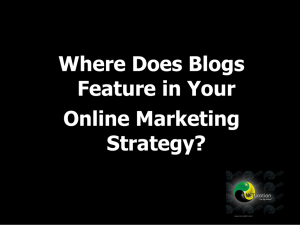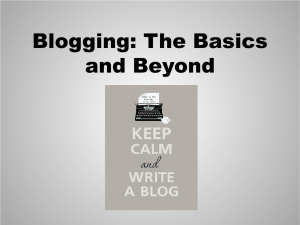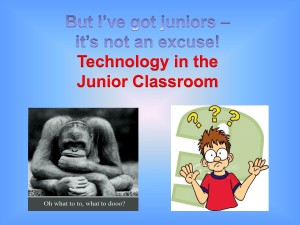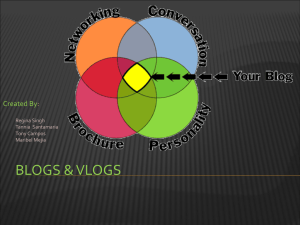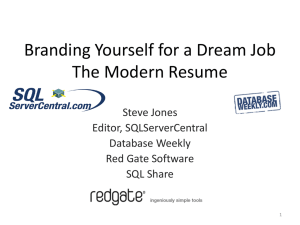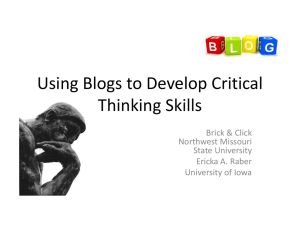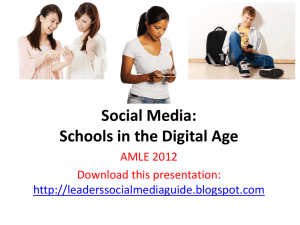05 - PowerPoint Slides
advertisement
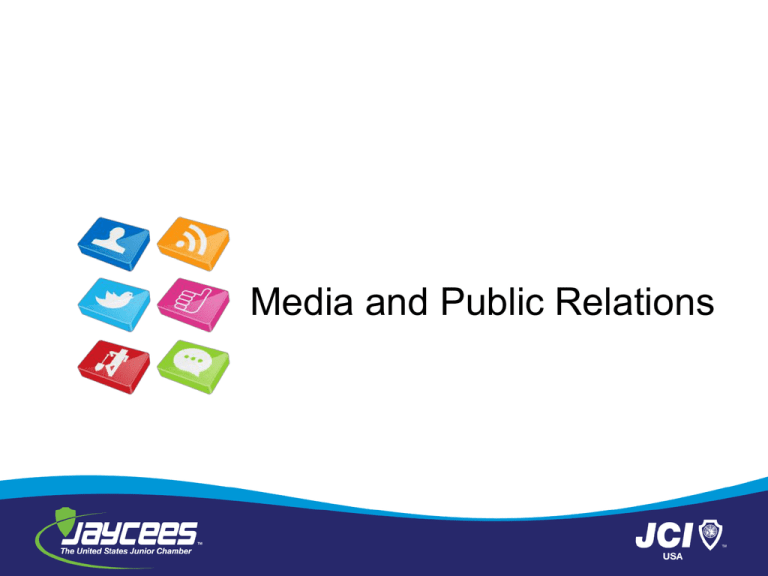
Media and Public Relations Welcome to the Media Relations and Advertising workshop. In this workshop, you will get knowledge you need to manage effectively your image and value by forming solid networks through strategic communication planning. The public is the only critic whose opinion is worth anything at all. Mark Twain Module Two: Dressing for Success Understanding what is communicated through the clothes you wear will help you develop a wardrobe that will enhance your networking and public relations goals. In this module, you will learn the following: • The meaning of colors • Interpreting common dress codes • Deciding what to wear Dressing is a way of life. Yves Saint Laurent The Meaning of Colors • • • • • • • Red = action, courage, vitality and confidence Brown = order and convention Green = life and well being Blue = youth and peace White = cleanliness Black = stability Gray = security and maturity Interpreting Common Dress Codes Business casual is more formal and is similar to appropriate attire but without T-shirts of any kind. Khakis and polo shirts are the most common garments worn in a business casual environment. Business professional is more stringent and may be the most common dress codes for networking events in the business world. Deciding What to Wear • • • • Place- determine where the event will be held. If it is at a fancy restaurant, then you know that business causal or professional is more where you should begin. Environment- the environment is also a helpful indicator on what to wear. If the event is outdoors on a boat, beach, or golf course, then this could be less formal or require special clothes. Attendees- who will be attending is another helpful indicator on what to wear. Reason- the reason for the function is also a key indicator of what to wear. Module Three: Writing Great written communication will help you demonstrate your value and ability to convey ideas. In this module, you will learn the basic structure of the following types of written communication: • Business letters • Proposals • Reports • Executive summaries Sponsors will want to see a written plan for your event or project. Easy reading is damn hard writing. Nathaniel Hawthorne Business Letters • Letterhead or return address • Date- type this two to six lines below the letterhead/return address. • Inside address- this is the address of the recipient. The first line should include the recipient’s name. This is then followed by their address. • Salutation- if you know the person’s name use Mr., Mrs., or Ms., and their last name only. Remember if you are writing to a doctor, use Dr. • The body of the letter- try keeping this brief and specific. Business letters should not be too long. • Complimentary close- there are many ways to close your letter. To make it simple, use “Sincerely”. • Signature block- after you complimentary close, add three spaces and then type your full name. Writing Proposals • • • • • • • • Summary: this is a brief and concise statement of your request along, including information about yourself, your overall plan, what you need in terms of resources and money. Introduction: History, Accomplishments, Company background Problem/Need Statement: state the specific problem or need. Explain how your proposal will correct or meet that need. Use data as applicable. Objectives should be derived from you problem or need statement. Methods: tell specifically what you plan to do. Why you want to do it and how you plan to resource your project with people. Evaluation: discuss how you plan to measure success. Funding needs: provide a cost/benefit statement. Also, if possible, provide how the project will bring a return on the investment. Budget: provide a summary of how you plan to use the funds. Reports • • • • • • • Title section: this could be a title page or it includes a table of contents if the report is lengthy. Summary: this section should contain a concise description of the main points, conclusions, and recommendations. Introduction: in this section, you should provide the background of the situation or problem and demonstrate to your target audience the importance of this report. Main body: this portion of the report may contain several sections with subtitles. Conclusion: your conclusion should be logical and should strive to pull the investigation together. Recommendations: provide a suggestion. Make a clear and determined statement in plain English. Appendices: in this area, you will put your technical data that supports your report. The language here can be very technical. Executive Summaries Here are some recommendations the style of your executive summary: • Be succinct • Use a very structured format for the layout of your summary • Design your summary so it can be placed onto a slide for presenting • The reference page should always begin on a new page Module Four: Media Relations Managing media relations is another facet to networking. In this module, you will learn how to leverage the following type of media: • • • Television Print Web, blogs and the Internet Television doesn’t make stars. It’s the written media, the press, that makes stars. Chevy Chase Advertising vs. Public Relations The basic difference between advertising and public relations is cost and credibility. Advertising costs money and people are not as fast to trust it. Public relations, on the other hand, seems authentic to people because it is not possible to simply purchase media coverage. Getting television coverage is not as easy as getting coverage in print or online. The Target Audience Always keep your target audience in mind. Your target audience represents the group of people you seek to reach with your message. For the United States Junior Chamber, the target audience is young, active citizens ages 18 to 40 who will respond well to a mission centered on positive change. Always keep these individuals in mind. Delivering a message in a way that skips this group or reaches a lot of people outside that description will be inefficient. Print • Print media typically can vary in cost greatly. However, because it exists as a physical product, it can be given from one viewer to another easily. It is easier to hand someone a magazine than to get them to click on a link. • Print media allows you the ability to select where you want your message to appear geographically. • Also provides flexibility in the size or space of the advertisement. • Can be expensive. Getting coverage in an article will be more affordably and credible than paying for space. • If you do purchase an ad, consider hiring a professional. People will judge your organization based on the quality of your design. Buying Advertisements for the Contact Lists Most advertising packages include a list of leads or subscribers. As an advertiser you have the ability to further reach out to the subscribers through e-mail blasts or newsletters. The advertisement will not do all the work itself. If you decide to purchase a print advertisement be sure to create a communications plan to ensure you reach people in meaningful ways. Pay special attention to the e-mail subject because that helps determine if people will open it. Also remember that it is less expensive and more effective to be featured in an article because people do not trust advertisements. Web Presence Blogs & the Internet Hosting companies usually offer a basic package with you Web site that includes a blogging application. Setting up your blog would take a few steps and your Web hosting company would provide the instructions. You need to practice using the blogging application, but once you gain the understanding, you will be writing content in no time. If you have the budget, you may hire a writer to help you update your blog. Leaving comments and contributing to discussions on other blogs and social media will drive traffic to your site. Television 2.0 Youtube offers many advantages in today’s market. Creating a youtube channel for your local organization will allow you to share videos affordably and discover what content moves people. If people share your youtube videos on facebook, you’ve struck gold. Module Five: Issues and Crisis Communication Planning Face the crisis head on. Trying to hide it will only make it worse. In fact, how you handle a crisis can be even more powerful than the crisis itself. Having a plan before a crisis occurs will help you take better control of the situation and project confidence to your audience. A crisis is an opportunity riding the dangerous wind. Chinese Proverb In this module, you will learn the following: • • • • Gauging the crisis level Provide feedback and insight How information will be distributed Track overall effect Gauging the Impending Crisis Level • • • • • What happened? Why did it happen? Who is impacted? What are the ramifications? Who is liable? Providing Feedback and Insights • Research and gather as much information about the crisis as possible. Try to find similar situations that you can draw parallels from and determine how they apply to the current crisis. • Understanding of all parties involved is necessary. Try to see all points of view so you can provide unbiased feedback and insight. If you are clearly favor one side, you will find it difficult to connect with all parties involved. • Neutral point-of-view is necessary. When giving your thoughts and insight about a crisis, providing a neutral point-ofview is necessary if you want your message to be heard. Avoid blaming others. Avoid speculation and know your limits. How Your Response Will be Distributed • Party to contact • How should they be contacted (ex. email, letter, phone or in person) • What should be communicated • When should they be communicated • Who is responsible or owner for communicating to that party • The date this party was actually contacted Tracking the Overall Effect of Bad Publicity • • • • • • • Date How the data was found Name of the source What was said Popularity of the source How does this affect your organization Can you respond to the source Module Six: Social Media (The PR Toolkit) Social media is a powerful tool that can increase the scope of your network greatly. Understanding the various types of social media outlets will help you formulate a strategy that can employ one or more of these tools. In this module, you will learn about the following social media tools: • Blogs • Wikis • Podcasts • Social bookmarks • RSS feeds Social networking sites like MySpace, Friendster and Facebook have literally exploded in popularity in just a few short years. Mike Fitzpatrick Blogs • A blog is short for a weblog, which is a journal made available on the World Wide Web. • Blogging is the activity of updating the blog. • The journal is in chronological order and the blog could contain pictures and other media for sharing. Wikis • • • • A wiki is a database that contains pages that a visitor can edit. The comments on a wiki build the page. It is a system of sharing an adapting the page as the comments are entered. Usually there is a moderator to a wiki. They approve the comments before they are added to the page. Podcasts • • Podcasts are audio or video files that are meant to be viewed on your computer or downloaded onto a portable device. If you are able to create videos or audio files and make them downloadable files, then you can create podcasts. Social Bookmarks • • • • Many times, you may want to share great information found on Websites you encounter throughout your life. Social bookmarking is a way for you to organize these links onto a Webpage and share it with others. The social bookmarking system allows you to save links to web pages for sharing with others. These bookmarking pages can be public or private. RSS Feeds • • • • A Really Simple Syndication or RSS is a feed that transmits updates from subscribed Websites. This is a useful tool when a Website is constantly updated. Websites that offer this feature usually has the RSS symbol that when clicked adds it to your web browser as a feed. For networking, you should add this feature to your web pages and blogs. Make it Easy for People to Help Create a sample Twitter feed about your events and send it to likeminded organizations so they can spread the word to their audience. Search for websites that will allow you write and schedule your tweets at once so you can create your tweets in one sitting. Use #hashtags to let external audiences know what your organization is about. If sharing success raising money for Nothing but Nets, mention #nothingbutnets in your tweet to get more attention. Module Seven: Member Communications Communication works for those who work at it. John Powell In this module, you will learn the following topics on employee communication: • Verbal communication • Non-verbal communication • Email etiquette • Negotiation skills • Making an impact Verbal Communication • • • Verbal communication is the art of being able to say something with the least words possible. The listener retains about 10 percent of what you say. Keeping your verbal communication short and simple makes you a better verbal communicator. Non-Verbal Communication Skills (Body Language) • • • • Distance—the amount of space between people could indicate attraction, conflict or avoidance. Orientation—how people place themselves indicates their attitude towards the other person. Posture—how a person carries himself or herself is another indicator of their attitude. Physical contact—behaviors like shaking hands demonstrates a willingness to engage the person. Avoiding any contact could be interpreted as apprehension. Email Etiquette • • • • • • • Avoid using email to write a long letter. Most people will not read the entire email if they have to scroll through it. Avoid getting straight to the point to your email. Do not forget to be polite and use common courtesies. Do not use shorthand or text messaging abbreviations in your emails. Make sure to use spell check and that you use proper grammar in your emails. Remember your written communication speaks volumes about you. Remember to say please and thank you. If you are contacting someone who is unfamiliar to you, avoid using his or her first name. Instead, use Mr., Mrs., etc. Never type your email in all capital letters. This is seen as screaming and is difficult to read. Making an Impact HERE ARE SOME SIMPLE WAYS TO CREATE IMPACT WITH OTHERS: • Be a listener. • Be a networker that networks both up and down. • Be a seeker of feedback. • Be ever enthusiastic about other people. Module Eight: Wrapping Up Although this workshop is ending, we hope that your journey to improve your Networking, Media, and Public Relations skills is just beginning. Please take a moment to review and update your action plan. This will be a key tool to guide your progress in the days, weeks, months, and years to come. We wish you the best of luck on the rest of your travels! Knowledge comes, but wisdom lingers. Alfred Lord Tennyson Words from the Wise • Bob Burg: The successful networkers I know, the ones receiving tons of referrals and feeling truly happy about themselves, continually put the other person’s needs ahead of their own. • Johan Arndt: Informal conversation is probably the oldest mechanism by which opinions on products and brands are developed, expressed, and spread. • Aldous Huxley: Experience is not what happens to a man; it is what a man does with what happens to him.
